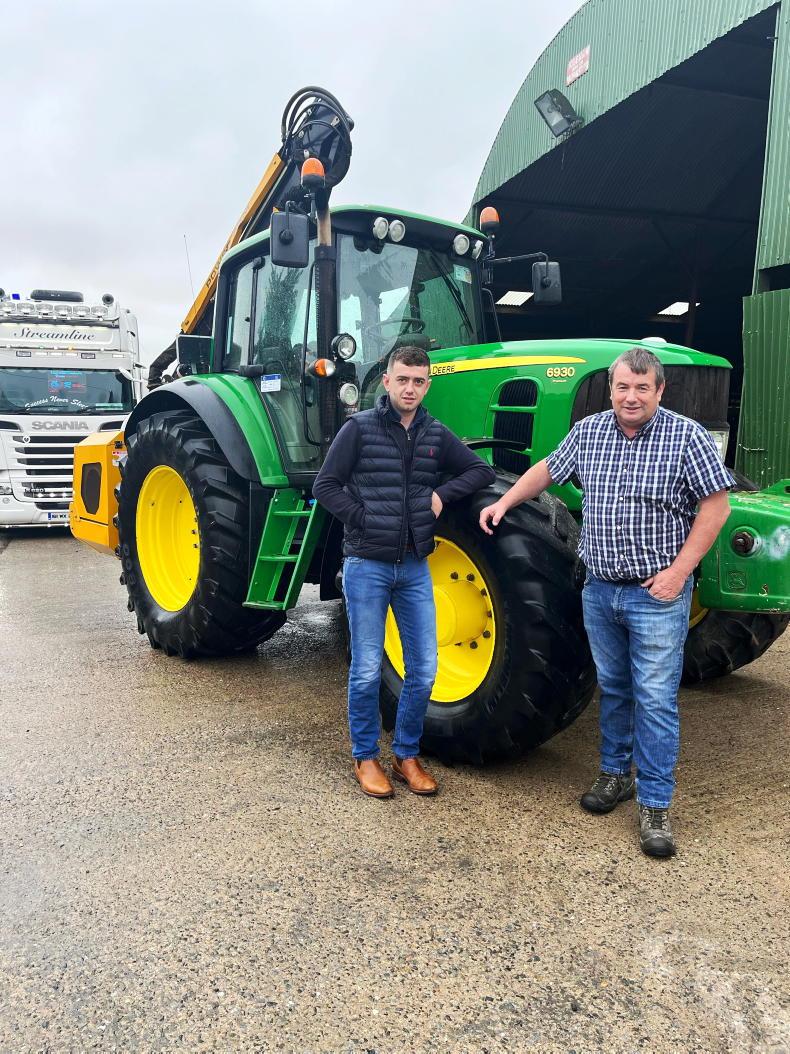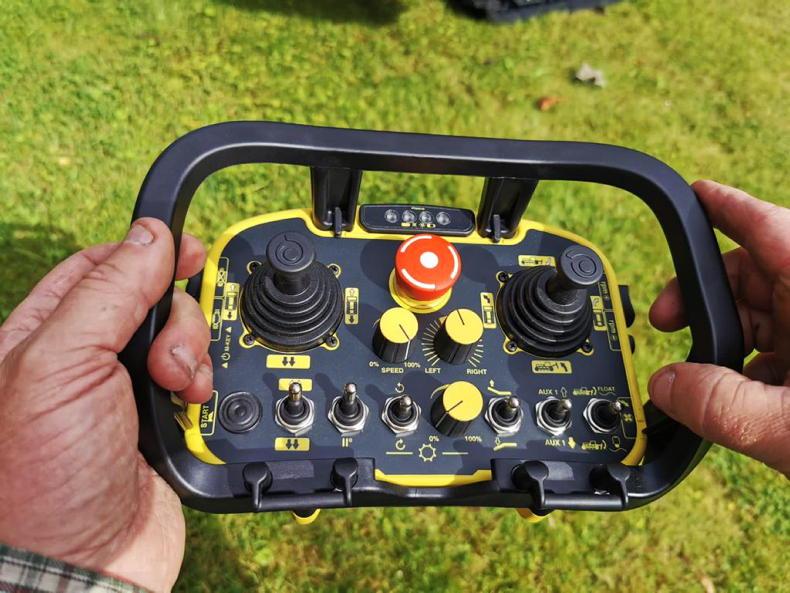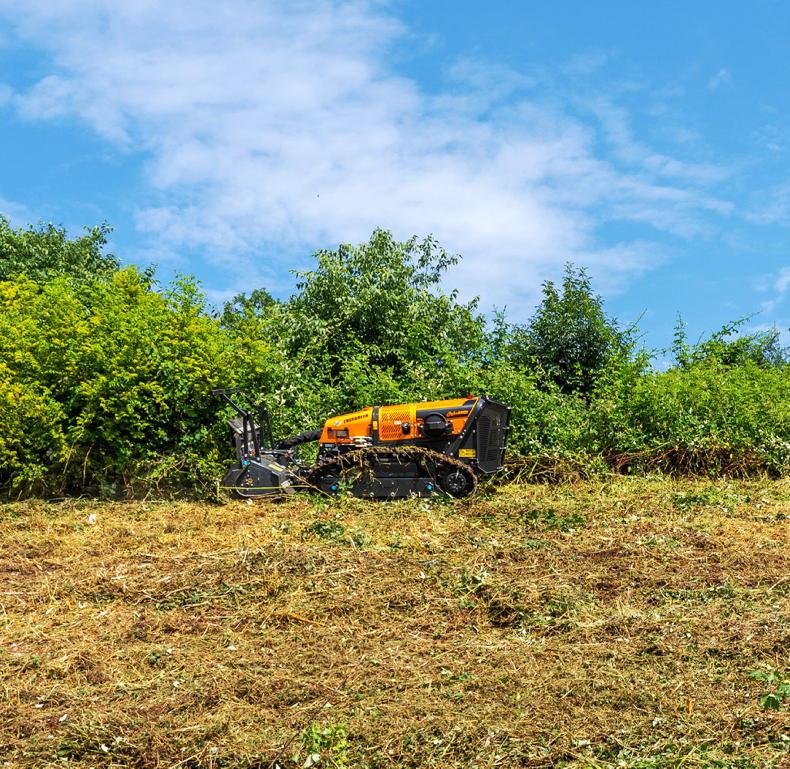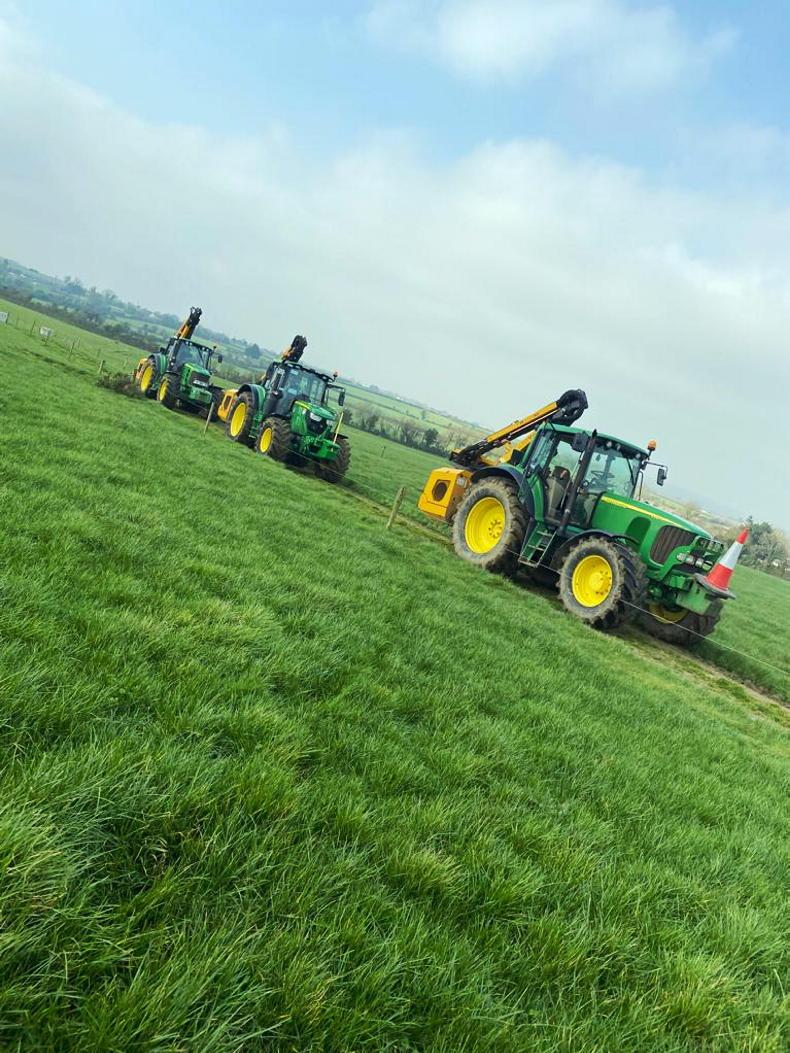The use of robotic and automated technology is continuing to grow across all walks of life.
Such technology is playing a key role in terms of improving safety in high-risk workplaces.
Examples in the machinery industry include robotic machines used in construction and demolition works, and when it comes to cutting steep verges and banks on the side of motorways and major roads.
This week, we caught up with one of a handful of contractors in Ireland who is using radio-controlled robotic mowers to keep vegetation under control on the steep banks of Irish motorways.
Based five miles outside Enniscorthy, Patrick Kinsella and his son Tom run a hedge-cutting contracting business, alongside a haulage business and growing 400 acres of malting barley.
Patrick first began hedge-cutting on hire 41 years ago, and has built up a considerable run of work over this period.
Always one to move with the times, Patrick took delivery of a new Energreen Robo Midi remote-controlled tool-carrier equipped with a flail head one year ago. 
Tom and Patrick Kinsella.
“We look after approximately 100km of motorway. Up to last year, we were cutting the bottom half of the bank from the road side with tractors and hedge cutters, while the remainder of the vegetation was being left to grow.
“The management company was keen for us to find a solution to cut the top of the banks.
“After looking into several machines, we took a demo of the Energreen Robo Midi and were extremely impressed. We found it to be a very capable and well-built machine. We purchased one shortly afterwards and took delivery at the end of August last year, just before the cutting season opened,” explained Patrick.
The machine
Built in Italy, the Robo Midi is a remote-controlled tool-carrier. The machine is designed to work in narrow areas, on slopes with a pitch of up to 55° and in areas with limited access.
The unit is powered by a 60hp Yanmar Stage V turbo diesel engine.
Energreen says the engine crankcase is designed to ensure full lubrication, even on steep slopes. The Robo Midi is also equipped with a self-cleaning reversible fan, a vital addition for its natural working environment, according to Patrick.
Equipped with a hydrostatic transmission, it features two speed ranges (low range 0-3km/h, high range 0-6km/h). Patrick notes that working speed varies depending on the type and density of the vegetation being cut, but that it would typically match walking speed.
Designed with a low centre of gravity, the latest version is fitted with a new track profile which allows a larger ground contact surface of the machine.
A new hydraulic tensioning system means the Robo Midi can work on slopes up to 55° in all directions.
Manufactured with a double roll bar integrated into the frame for protection, a flat bottom frame protects the engine, while fully enclosed body panels keep any grass and debris out.
The unit also features an independent cooling system of the hydraulic system.
Patrick’s unit features rubber tracks and weighs in at 1,640kg, while it also comes with the option of steel tracks which increases the overall weight to 1,750kg.
On these rubber tracks, the unit is 2,060mm long, 1,420mm wide and 1,160mm high.
The machine comes with a front linkage with a quick attachment mounting system. It features two double-acting hydraulic functions, meaning it can be equipped with various tools such as a flail cutting head, a forestry head, a stump grinder, and a bucket, etc.
The unit has a 250-hour service interval which the main dealer Green Equipment Supplies looks after. Patrick explained that daily maintenance includes greasing, checking the flails and cleaning down any debris. 
The unit is remotely controlled and can be controlled from up to 150 metres (492 feet) away.
As previously mentioned, the unit is remotely controlled. To ensure the safety of the operator, the unit can be controlled from up to 150m (492ft) away. Two large joysticks provide precise control of movement, steering and flail head height.
Speed and steering control can also be adjusted to suit the operator. The controller weighs in at 2kg.
“The machine is very straightforward to operate, it’s almost like a gaming console. We have several drivers trained to use the machine and tend to rotate the hedge cutter drivers. It’s vital that the operator is fully geared up with personal protective equipment,” explained Tom.
“The unit can be controlled from 150m away, but typically speaking, we would operate it from a safe distance of around 20m away as it’s also important to see what you’re cutting.
“The operator always walks behind or beside the machine, as foreign objects could potentially fly from the cutting unit at the front. We would generally cut banks over and back where possible, but some extremely steep banks can only be cut up and down. The machine is very capable on steep banks, but like anything it has its limitations. In very wet weather, it would slide down such steep banks,” Tom added. 
The machine comes with a front linkage with a quick attachment mounting system and can be equipped with various tools such as a mulching head.
“On a typical nine-hour day, the unit runs the 1.6m flail head on around 50l of diesel. Comparing this to one of our John Deeres and McConnel hedge cutters which are fitted with the standard 1.2m head, they would burn 12-13l/hour. With similar output capacities cutting typical vegetation across the run of the day, the tractor will burn around 62-63 litres of fuel more”.
“We are very happy with how the Robo Midi has worked out. We put over 600 working hours through the machine last year and with the exception of breaking a few bolts, the machine hasn’t given a day’s bother. It’s very robustly built and it does exactly what it’s supposed to. We have decided to invest in a second new unit for the season ahead and hope to be taking delivery shortly,” outlined the father-and-son team.
Patrick started off his hedge-cutting career 41 years ago with a John Deere 2130 and a McConnel 5m Hi Reach hedge cutter. As his workload grew down through the years, Patrick continued to expand his outfit.
“Our workload is divided to roughly 75% private work and 25% municipal road work. One time, we would be flat out doing private work as soon as the cutting window opened right through until it closed again the following spring. However, we find that nowadays the cutting window is getting shorter.
“People only want you working in dry weather. We cut a lot of hedges on tillage ground and always have, many of our customers have gone down the route of eco tillage. Moving away from the plough, there is more of a focus on soil structure and these guys want you in and out in dry weather. More and more guys are also sowing cover crops so the window for cutting hedges is limited.
“I started off with John Deere and McConnel and I stuck with the two brands down through the years. In terms of the hedge cutters, we run three machines – a 6585T, a 6575T and a 7775T. We do a lot of work and reliability is very important.
“We have an agreement with our dealer where we trade the three machines for three new machines every two years. The dealer gives us a two-year warranty, which means we know exactly what our running costs are.
“Years ago, we would have run the machines on longer, but we found occasional electronic trouble such as replacing an electronic control unit (ECU) can be costly and something that you can’t prepare for or maintain. It usually goes without warning and could cost €3,500 to €4,000 to replace.
“I’ve always been a John Deere man. I started off with the 30 series, moved to the 40 series, followed by the 50 series and then on to a 6900. I also ran a 6910 which was the best tractor I ever had. Today, the fleet consists of a 6610, a 6920s, a 6930, a 6150R and a 6155R. I think they are a brilliant tractor. Both the 6610 and 6920s have 20,000 hours and the only issue I’ve had between both tractors over the years is one water pump,” explained Patrick.
Maximum slope: 55°.Engine: four-cylinder Yanmar.Horsepower: 60hp.Fuel tank capacity: 30 litres.Weight: 1,640kg on rubber tracks (1,750kg on steel tracks).Transmission: hydrostatic.Low range speed: 0-3km/h.High range speed: 0-6km/h. Remote working range: 150m.Starting price: €70,000 plus VAT.
The Kinsellas run three machines, a 6585T, a 6575T and a 7775T and upgrade them every two years.
The use of robotic and automated technology is continuing to grow across all walks of life.
Such technology is playing a key role in terms of improving safety in high-risk workplaces.
Examples in the machinery industry include robotic machines used in construction and demolition works, and when it comes to cutting steep verges and banks on the side of motorways and major roads.
This week, we caught up with one of a handful of contractors in Ireland who is using radio-controlled robotic mowers to keep vegetation under control on the steep banks of Irish motorways.
Based five miles outside Enniscorthy, Patrick Kinsella and his son Tom run a hedge-cutting contracting business, alongside a haulage business and growing 400 acres of malting barley.
Patrick first began hedge-cutting on hire 41 years ago, and has built up a considerable run of work over this period.
Always one to move with the times, Patrick took delivery of a new Energreen Robo Midi remote-controlled tool-carrier equipped with a flail head one year ago. 
Tom and Patrick Kinsella.
“We look after approximately 100km of motorway. Up to last year, we were cutting the bottom half of the bank from the road side with tractors and hedge cutters, while the remainder of the vegetation was being left to grow.
“The management company was keen for us to find a solution to cut the top of the banks.
“After looking into several machines, we took a demo of the Energreen Robo Midi and were extremely impressed. We found it to be a very capable and well-built machine. We purchased one shortly afterwards and took delivery at the end of August last year, just before the cutting season opened,” explained Patrick.
The machine
Built in Italy, the Robo Midi is a remote-controlled tool-carrier. The machine is designed to work in narrow areas, on slopes with a pitch of up to 55° and in areas with limited access.
The unit is powered by a 60hp Yanmar Stage V turbo diesel engine.
Energreen says the engine crankcase is designed to ensure full lubrication, even on steep slopes. The Robo Midi is also equipped with a self-cleaning reversible fan, a vital addition for its natural working environment, according to Patrick.
Equipped with a hydrostatic transmission, it features two speed ranges (low range 0-3km/h, high range 0-6km/h). Patrick notes that working speed varies depending on the type and density of the vegetation being cut, but that it would typically match walking speed.
Designed with a low centre of gravity, the latest version is fitted with a new track profile which allows a larger ground contact surface of the machine.
A new hydraulic tensioning system means the Robo Midi can work on slopes up to 55° in all directions.
Manufactured with a double roll bar integrated into the frame for protection, a flat bottom frame protects the engine, while fully enclosed body panels keep any grass and debris out.
The unit also features an independent cooling system of the hydraulic system.
Patrick’s unit features rubber tracks and weighs in at 1,640kg, while it also comes with the option of steel tracks which increases the overall weight to 1,750kg.
On these rubber tracks, the unit is 2,060mm long, 1,420mm wide and 1,160mm high.
The machine comes with a front linkage with a quick attachment mounting system. It features two double-acting hydraulic functions, meaning it can be equipped with various tools such as a flail cutting head, a forestry head, a stump grinder, and a bucket, etc.
The unit has a 250-hour service interval which the main dealer Green Equipment Supplies looks after. Patrick explained that daily maintenance includes greasing, checking the flails and cleaning down any debris. 
The unit is remotely controlled and can be controlled from up to 150 metres (492 feet) away.
As previously mentioned, the unit is remotely controlled. To ensure the safety of the operator, the unit can be controlled from up to 150m (492ft) away. Two large joysticks provide precise control of movement, steering and flail head height.
Speed and steering control can also be adjusted to suit the operator. The controller weighs in at 2kg.
“The machine is very straightforward to operate, it’s almost like a gaming console. We have several drivers trained to use the machine and tend to rotate the hedge cutter drivers. It’s vital that the operator is fully geared up with personal protective equipment,” explained Tom.
“The unit can be controlled from 150m away, but typically speaking, we would operate it from a safe distance of around 20m away as it’s also important to see what you’re cutting.
“The operator always walks behind or beside the machine, as foreign objects could potentially fly from the cutting unit at the front. We would generally cut banks over and back where possible, but some extremely steep banks can only be cut up and down. The machine is very capable on steep banks, but like anything it has its limitations. In very wet weather, it would slide down such steep banks,” Tom added. 
The machine comes with a front linkage with a quick attachment mounting system and can be equipped with various tools such as a mulching head.
“On a typical nine-hour day, the unit runs the 1.6m flail head on around 50l of diesel. Comparing this to one of our John Deeres and McConnel hedge cutters which are fitted with the standard 1.2m head, they would burn 12-13l/hour. With similar output capacities cutting typical vegetation across the run of the day, the tractor will burn around 62-63 litres of fuel more”.
“We are very happy with how the Robo Midi has worked out. We put over 600 working hours through the machine last year and with the exception of breaking a few bolts, the machine hasn’t given a day’s bother. It’s very robustly built and it does exactly what it’s supposed to. We have decided to invest in a second new unit for the season ahead and hope to be taking delivery shortly,” outlined the father-and-son team.
Patrick started off his hedge-cutting career 41 years ago with a John Deere 2130 and a McConnel 5m Hi Reach hedge cutter. As his workload grew down through the years, Patrick continued to expand his outfit.
“Our workload is divided to roughly 75% private work and 25% municipal road work. One time, we would be flat out doing private work as soon as the cutting window opened right through until it closed again the following spring. However, we find that nowadays the cutting window is getting shorter.
“People only want you working in dry weather. We cut a lot of hedges on tillage ground and always have, many of our customers have gone down the route of eco tillage. Moving away from the plough, there is more of a focus on soil structure and these guys want you in and out in dry weather. More and more guys are also sowing cover crops so the window for cutting hedges is limited.
“I started off with John Deere and McConnel and I stuck with the two brands down through the years. In terms of the hedge cutters, we run three machines – a 6585T, a 6575T and a 7775T. We do a lot of work and reliability is very important.
“We have an agreement with our dealer where we trade the three machines for three new machines every two years. The dealer gives us a two-year warranty, which means we know exactly what our running costs are.
“Years ago, we would have run the machines on longer, but we found occasional electronic trouble such as replacing an electronic control unit (ECU) can be costly and something that you can’t prepare for or maintain. It usually goes without warning and could cost €3,500 to €4,000 to replace.
“I’ve always been a John Deere man. I started off with the 30 series, moved to the 40 series, followed by the 50 series and then on to a 6900. I also ran a 6910 which was the best tractor I ever had. Today, the fleet consists of a 6610, a 6920s, a 6930, a 6150R and a 6155R. I think they are a brilliant tractor. Both the 6610 and 6920s have 20,000 hours and the only issue I’ve had between both tractors over the years is one water pump,” explained Patrick.
Maximum slope: 55°.Engine: four-cylinder Yanmar.Horsepower: 60hp.Fuel tank capacity: 30 litres.Weight: 1,640kg on rubber tracks (1,750kg on steel tracks).Transmission: hydrostatic.Low range speed: 0-3km/h.High range speed: 0-6km/h. Remote working range: 150m.Starting price: €70,000 plus VAT.
The Kinsellas run three machines, a 6585T, a 6575T and a 7775T and upgrade them every two years.










 This is a subscriber-only article
This is a subscriber-only article










SHARING OPTIONS: